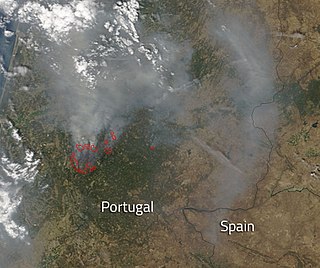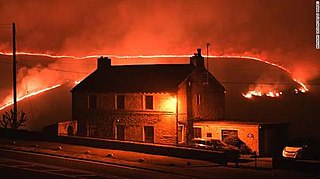
Palmitos Park is a 20-hectare (49-acre) botanical garden, aviary and zoo on the island of Gran Canaria, Canary Islands, Spain.
Tourism is an essential part of the economy of the Canary Islands, a Spanish archipelago located in the Atlantic Ocean, 100 kilometres west of Morocco. Seven main islands and six islets make up the Canary Islands. They had more than 9 million foreign incoming tourists in 2007. Tourists seeking sunshine and beaches first began to visit the Canaries in large numbers in the 1960s. The Canary Islands are a leading European tourist destination with very attractive natural and cultural resources.

The 2009 Mediterranean wildfires were a series of wildfires that broke out across France, Greece, Italy, Spain, and Turkey in July 2009. Strong winds spread the fire during a hot, dry period of weather killing at least eight people, six of whom were in Spain. Some of the wildfires were caused by lightning, along with arson and military training.
The 2012 Chios Forest Fire was a wildfire that broke out in the southern half of the Greek island of Chios shortly after 2 a.m. on Saturday 18 August 2012.
The Great Fire of Valparaíso started on 12 April 2014 at 16:40 local time, in the hills of the city of Valparaíso, Chile. The wildfire destroyed at least 2,500 homes, leaving 11,000 people homeless. An additional 6,000 people were evacuated from the city, which was placed on red alert and declared a disaster zone. Fifteen people were confirmed killed and ten suffered serious injuries.

The October 2007 California wildfires, also known as the Fall 2007 California firestorm, were a series of about thirty wildfires that began igniting across Southern California on October 20. At least 1,500 homes were destroyed and approximately 972,147 acres of land was burned from Santa Barbara County to the U.S.–Mexico border, surpassing the October 2003 California wildfires in scope, which were estimated to have burned 800,000 acres (3,200 km2). The wildfires killed a total of 14 people, with nine of them dying directly from the fires; 160 others were injured, including at least 124 firefighters. At their height, the raging fires were visible from space. These fires included the vast majority of the largest and deadliest wildfires of the 2007 California wildfire season. The only wildfire in 2007 that surpassed any of the individual October 2007 fires in size was the Zaca Fire.

The 2016 Portugal wildfires are a series of wildfires that burned across mainland Portugal and the Madeira archipelago in the north Atlantic Ocean during August 2016 that prompted the evacuation of more than one thousand people and destroyed at least 37 homes near Funchal on Madeira island. Flights were also disrupted at Cristiano Ronaldo International Airport due to high levels of smoke.

A series of four initial deadly wildfires erupted across central Portugal in the afternoon of 17 June 2017 within minutes of each other, resulting in at least 66 deaths and 204 injured people.

A series of 29 wildfires ignited across Southern California in December 2017. Six of the fires became significant wildfires, and led to widespread evacuations and property losses. The wildfires burned over 307,900 acres (1,246 km2), and caused traffic disruptions, school closures, hazardous air conditions, and power outages; over 230,000 people were forced to evacuate. The largest of the wildfires was the Thomas Fire, which grew to 281,893 acres (1,140.78 km2), and became the largest wildfire in modern California history, until it was surpassed by the Ranch Fire in the Mendocino Complex, in the following year.

2019 United Kingdom wildfires were a series of wildfires that began on 26 February 2019 and ended on 18 May 2019. The series of wildfires was considered unusual due to the fact that they took place early in the year. Areas affected by the wildfires in 2019 included those that had already been burnt by wildfires during the summer of 2018. The fires have created many air pollution problems for the UK. The causes of most of the fires have been attributed to much higher than average temperatures and drought conditions that have prevailed since the spring of 2018. There were 137 wildfires larger than 25 hectares (250,000 m2) recorded in the United Kingdom in 2019. This beats the previous record of 79 from 2018.

The 2020 Córdoba wildfires are a series of wildfires burning through the Córdoba Province in Argentina.
The Chilean Patagoniawildfire was a wildfire affecting Patagonia Park in Aysén Region, southern Chile. The fire begun on Friday July 2, 2021 around 22:00 local time. Radio Cooperativa reported in the night of July 2, 2021 that the fire could be observed 80 km (50 mi) away in the town of Cochrane. It was expected that incoming rain would help mitigate the fire. As of July 3, 2021, 150 hectares have burnt. National Office of Emergency of the Interior Ministry declared the fire a "red alert" emergency on July 3, 2021. By July 7 the fire was "under control but not yet extinguished".

The 2021 Greece wildfires were multiple wildfires in Greece in August 2021, which killed 3 people, injured at least 20 others and burned dozens of homes, after a historic heatwave for the country, with the highest temperatures reaching 47.1 °C (116.8 °F). Authorities evacuated several villages and towns. According to BBC News, Greece experienced the worst heatwave since 1987. These fires were the worst fires in Greece since the 2007 Greek forest fires which burnt more than double the area of the 2021 fires.
The 2022 Tierra del Fuego wildfire is a fire affecting the Chilean commune of Timaukel in the west of Tierra del Fuego Island in southernmost South America. The fire was discovered on January 20 but since no flames could be found it was reportedly believed that it was already extinguished. It began in land owned by the forestry company Forestal Russfin. Days later the fire was envigorated and consumed various hectares of forest.

In June through August 2022, parts of Europe, the Middle East and North Africa were affected by wildfires. The bulk of the fires affected Mediterranean Countries, with the main areas affected being Algeria, France, Greece, Portugal and Spain.

Starting on 30 January 2023, a series of wildfires began in the South American country of Chile. By early February, the fires had developed into a large outbreak of at least 406 individual fires, several dozen of which were classified as "red alert fires". The fires burned more than 430,000 hectares and resulted in the loss of 24 lives, prompting the government to declare a state of emergency in multiple regions of the country.
The 2023 Italy wildfires are multiple ongoing wildfires in Italy which started in July 2023.












